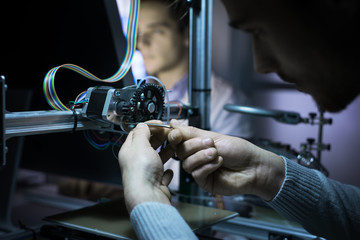Have you ever wondered about the genius behind 3D printing? Well, let us introduce you to Chuck Hull, the visionary inventor who revolutionized the print industry. In the early 1980s, Hull’s invention of stereolithography, also known as 3D printing, changed the game. By printing layer upon layer of plastic, he made it possible to create three-dimensional objects like never before. Join us as we delve into Hull’s remarkable journey and explore the impact of his invention on the world of 3D printing.
The Invention of Stereolithography
Chuck Hull’s invention of stereolithography revolutionized the manufacturing industry by introducing a groundbreaking method of creating three-dimensional objects. In 1983, Chuck Hull, also known as Charles Hull, invented stereolithography, which is now commonly referred to as 3D printing. This invention marked the birth of the first 3D printer and forever changed the way objects are manufactured. Hull’s patent for stereolithography was granted in 1986, and he went on to co-found 3D Systems, a company that produced the first-ever 3D printer, the SLA-1 Stereolithography printer, in 1987.
Stereolithography utilizes a process of printing thin layers of ultraviolet curable materials to create objects. This technology quickly gained popularity and was widely used in rapid prototyping and direct manufacturing. Industries such as car manufacturing, aerospace, and medical printing began utilizing Hull’s systems for building prototypes and producing various components.
Chuck Hull’s invention of stereolithography has earned him numerous accolades and recognition. He holds 93 US and 20 European patents and was awarded the European Inventor Award in 2014 for his groundbreaking invention. In 2015, he received the IRI Achievement Award for his significant contributions to the field of 3D printing.
Looking towards the future, Hull predicted that 3D printing would become more affordable and reach private households, a prediction that came true around 2010. He believes that 3D printing will continue to advance and become the recognized way to manufacture both plastic and metal parts. With its vast potential for innovation and creativity, the future of 3D printing holds tremendous opportunities.
Impact on the Print Industry
The invention of stereolithography by Chuck Hull has had a significant impact on the print industry, revolutionizing the way objects are manufactured and opening up new possibilities for rapid prototyping and direct manufacturing. Chuck Hull’s pioneering work in 3D printing, also known as additive manufacturing, has transformed traditional printing methods by allowing the creation of three-dimensional objects layer by layer. This breakthrough technology has revolutionized industries such as automotive, aerospace, and medical printing.
With the introduction of 3D printing, manufacturers can now produce complex and customized objects with greater speed and efficiency. Traditional manufacturing methods often involve time-consuming processes and expensive tooling, but 3D printing has simplified and accelerated the production of prototypes and final products. Chuck Hull’s invention has made it possible to create intricate designs and functional parts directly from digital models, eliminating the need for molds or machining.
Furthermore, 3D printing has democratized manufacturing by providing accessibility to small businesses, entrepreneurs, and individuals. This technology has empowered innovators to bring their ideas to life without the constraints of traditional manufacturing processes. The impact of Chuck Hull’s invention has been far-reaching, inspiring a new wave of creativity and innovation in the print industry.
Chuck Hull’s Background and Education
How did Chuck Hull’s background and education contribute to his success in inventing 3D printing?
Chuck Hull’s background and education played a crucial role in his success as the inventor of 3D printing. Here’s how his experiences and knowledge shaped his groundbreaking invention:
– Engineering Physics Education: Chuck Hull studied engineering physics at the University of Colorado, equipping him with a deep understanding of scientific principles and practical applications. This educational foundation provided him with the necessary technical skills and problem-solving abilities to tackle the challenges of creating a new printing technology.
– Technical Expertise: With a degree in engineering physics, Hull possessed a strong background in mathematics, physics, and engineering. This expertise allowed him to develop the complex systems and processes required for 3D printing, including the manipulation of ultraviolet curable materials and the creation of precise layered structures.
– Hands-on Experience: After completing his education, Hull gained valuable experience working in various engineering and technical roles. This hands-on experience provided him with a practical understanding of manufacturing processes and the ability to identify inefficiencies in traditional prototyping methods, which ultimately led to his “Aha” moment and the invention of stereolithography.
– Innovative Thinking: Hull’s background in engineering physics fostered a mindset of innovation and problem-solving. His ability to think outside the box, combined with his technical knowledge, allowed him to envision a new approach to prototyping that would revolutionize the manufacturing industry.
The ‘Aha’ Moment and Application of 3D Printing
After gaining valuable experience in engineering and technical roles, you had a pivotal ‘Aha’ moment that led to the application of 3D printing technology in various industries. Your frustration with the tedious process of prototyping plastic parts sparked an idea. You realized that by printing layers of plastic, you could create proper plastic parts more efficiently.
In 1984, you applied for a patent for stereolithography, which used thinly printed layers of ultraviolet curable materials. This invention revolutionized industries such as car manufacturing, aerospace, and medical equipment. Your 3D printing technology became widely used in rapid prototyping and direct manufacturing, with companies like General Motors and Mercedes-Benz utilizing your systems for building prototypes. Your achievements include holding 93 US and 20 European patents, receiving the European Inventor Award in 2014, and the IRI Achievement Award in 2015.
You predicted that 3D printers would become affordable for private households, which has since happened. You believe that 3D printing will be the recognized way to manufacture plastic parts and may advance to the same level for metal parts. The trend in 3D printing currently focuses on aerospace and medical parts, and you see tremendous opportunities for innovation and creativity in the future of 3D printing.
Chuck Hull’s Achievements and Recognition
Recognized for your significant contributions to the field of Chuck Hull 3D printing, you have received numerous accolades and awards for your groundbreaking invention of stereolithography. Your achievements and recognition speak to the impact and importance of your invention. Here are some highlights:
– Induction into the National Inventors Hall of Fame in 2014, acknowledging your pioneering role in the development of 3D printing.
– The Economist’s Innovation Award, which honored your significant contributions to the field of 3D printing and recognized your role in revolutionizing various industries.
– The European Inventor Award in 2014, which celebrated your invention of stereolithography and its impact on the world.
– The IRI Achievement Award in 2015, recognizing your ground-breaking invention and the profound influence it has had on the field of 3D printing.
These awards and accolades showcase the recognition and appreciation for your innovative work in the field of 3D printing. Your invention has truly transformed industries and opened up new possibilities for manufacturing and design. Your contributions continue to inspire and shape the future of 3D printing.
The Future of 3D Printing
Looking ahead, you can expect the future of 3D printing to bring even more advancements and opportunities for innovation in various industries. As technology continues to evolve, 3D printing is poised to revolutionize manufacturing processes and change the way we create and design products.
One key area of development in 3D printing is the use of new materials. Currently, most 3D printers primarily use plastics, but researchers are exploring the use of metals, ceramics, and even biological materials. This opens up possibilities for creating stronger and more complex objects, such as customized medical implants or lightweight aerospace components.
Another area of growth is in the size and speed of Chuck Hull 3D printers. Currently, most 3D printers are limited in terms of the size of objects they can produce and the time it takes to print them. However, advancements in technology are making it possible to print larger objects more quickly, allowing for the production of larger-scale prototypes and even finished products.
Additionally, the integration of 3D printing with other technologies, such as robotics and artificial intelligence, holds great promise. This could lead to automated 3D printing processes, where robots work alongside printers to streamline production and improve efficiency.
Early Forms of Communication
As we delve into the fascinating world of early forms of communication, let’s explore the various ways in which humans have expressed and conveyed messages throughout history.
– Cave paintings: Imagine ancient humans using pigments to create vivid images on the walls of caves, telling stories and preserving their experiences for future generations.
– Hieroglyphics: Picture the ancient Egyptians carving intricate symbols onto stone surfaces, conveying complex messages through their elaborate system of writing.
– Printing press: Visualize Johannes Gutenberg’s invention revolutionizing the spread of information, with movable type allowing for the mass production of books and the dissemination of knowledge.
– Telegraph: Envision the telegraph wires stretching across vast distances, enabling people to send messages across continents almost instantaneously through the use of electrical signals.
These early forms of communication laid the foundation for the development of more advanced systems of conveying information. They marked significant milestones in human history, shaping the way we communicate and connect with one another. From the dawn of time to the present day, the evolution of communication continues to shape our world and pave the way for future innovations.
Development of Writing Systems
During the early stages of human civilization, writing systems began to emerge as a means of communication and record-keeping. The Sumerians developed cuneiform writing in Mesopotamia, which involved making wedge-shaped marks on clay tablets. This system was later adopted by other civilizations in the region. The Phoenicians introduced the first alphabet, consisting of a set of symbols representing sounds, which greatly simplified the writing process.
The Chinese invented the system of characters known as Hanzi, which are still used today. The emergence of the Greek alphabet brought about a more phonetic approach to writing, while the Romans adopted and modified the Greek alphabet to create the Latin script, which is the basis for many modern alphabets. These writing systems allowed for the preservation of knowledge and the dissemination of information across time and space, laying the foundation for the development of literature, science, and culture.
Evolution of Printing and Publishing
The evolution of writing systems set the stage for the development of printing and publishing. This evolution can be traced through various milestones in human history:
– Invention of paper in ancient China: The invention of paper provided a medium for writing and paved the way for the mass production of written materials.
– The Gutenberg Bible as the first major book printed with movable type: Johannes Gutenberg’s invention of the printing press with movable type revolutionized the production of books and made them more accessible to the masses.
– The rise of newspaper printing during the Renaissance: The printing press allowed for the mass production of newspapers, leading to the spread of information and the democratization of knowledge.
– Introduction of the steam-powered printing press in the 19th century: The steam-powered press increased the speed and efficiency of printing, enabling the production of larger quantities of printed materials.
These advancements in printing technology transformed the way information was disseminated and consumed. It allowed for the widespread distribution of knowledge, facilitated the spread of ideas, and fueled the growth of education and literacy. The evolution of printing and publishing continues to this day with the development of digital printing technologies and the advent of e-books and online publishing platforms.



